Cite this document
(“The Importance of Tacit Knowledge in Strategic Research Proposal”, n.d.)
The Importance of Tacit Knowledge in Strategic Research Proposal. Retrieved from https://studentshare.org/management/1574935-essay-on-strategy
The Importance of Tacit Knowledge in Strategic Research Proposal. Retrieved from https://studentshare.org/management/1574935-essay-on-strategy
(The Importance of Tacit Knowledge in Strategic Research Proposal)
The Importance of Tacit Knowledge in Strategic Research Proposal. https://studentshare.org/management/1574935-essay-on-strategy.
The Importance of Tacit Knowledge in Strategic Research Proposal. https://studentshare.org/management/1574935-essay-on-strategy.
“The Importance of Tacit Knowledge in Strategic Research Proposal”, n.d. https://studentshare.org/management/1574935-essay-on-strategy.


